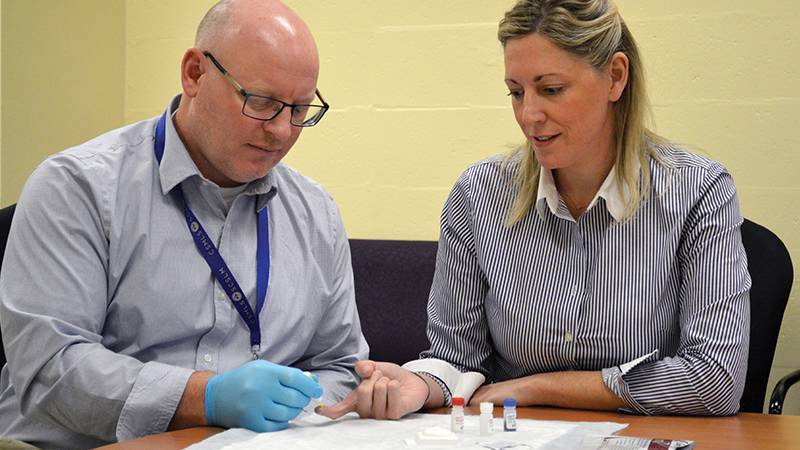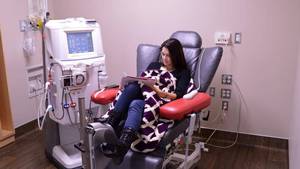In 2018, the number of new HIV infections in Halifax Regional Municipality (HRM) doubled among those who use injection drugs, compared to the previous two years. This is a trend that deeply concerns Matt Bonn, a frontline harm reduction support worker with Mainline Needle Exchange.
“I hear about unsafe using patterns from people first hand and I see more and more people contracting HIV,” he says. “A lot of youth as well, which is alarming.”
This sentiment is echoed by Dr. Lisa Barrett, an infectious diseases specialist at the QEII Health Sciences Centre and an assistant professor at Dalhousie University.
“HIV is a chronic infection and once you get it, you have it for life,” she explains. “While we can treat the infection well, we have to know about it. In the early days of the infection, a person may not know they have it, so getting tested is important.”
I’m excited for the QEII Foundation TRIC grant to give access to providers in a community-based setting because we lose so many people while trying the referral method.
— Matt Bonn
The medications that treat HIV are typically quite successful and, about 10 years ago, a medication became available to prevent future infection. When taken daily and combined with other harm reduction strategies — a process known as pre-exposure prophylaxis, or PrEP — it’s highly effective for preventing HIV from sex or injection drug use.
“PrEP is not just a pill; it’s a whole plan to reduce exposure to infections,” Dr. Barrett says. “This includes having safer sex, harm reduction if you inject drugs, as well as understanding your risk for infections spread through blood and sexual encounters. PrEP is a plan and an important part of that plan is this medication.”
With funding from a QEII Foundation Translating Research Into Care (TRIC) grant, Dr. Barrett and her team are monitoring the effectiveness of a community-based PrEP rollout in the HRM. QEII Foundation TRIC grants fuel direct and positive changes for health care, such as better patient outcomes and improved access to care.
Dr. Barrett’s innovative approach in combating HIV infection embodies the uniqueness of the grants — closing the often decades-long gap between research and practice. Matt is particularly enthused by the prospects.
“I’m excited for the QEII Foundation TRIC grant to give access to providers in a community-based setting because we lose so many people while trying the referral method,” he notes.
PrEP is not just a pill; it’s a whole plan to reduce exposure to infections.
— Dr. Lisa Barrett
Dr. Barrett’s study involves a three-pronged strategy to target those most at risk.
“PrEP involves education around HIV, easy testing for a patient to know their status and then access to PrEP if they need the medication,” she says.
Dr. Barrett first needed to understand what people in the at-risk community knew about HIV — from how it’s contracted to how to prevent it. With Matt’s help she was able to engage people in the community and provide awareness cards urging people to get tested.
The second part of the study saw Dr. Barrett and her team using a “point-of-person” blood test in the community. Approved by Health Canada but not normally offered for routine testing in Nova Scotia, the test is similar to a diabetes blood sugar test, with results available within minutes. But before treatment can start, the results need to be confirmed in a more comprehensive lab at the QEII, presenting another challenge unique to the high-risk community.
“The point-of-care finger prick test gives HIV results within five minutes,” Dr. Barrett says. “But if a random person gets a positive test, how do we make that part of the public health reporting and make this practical for patients with no health card, no driver’s licence and no fixed address?”
As Charles Heinstein, the manager of the QEII’s microbiology lab, can attest, these challenges extend into his realm as well.
“We’ve got incredible testing mechanisms and equipment and staff, but there are groups of the population that can’t access that,” he says. “With no health card number or social insurance number, there are no unique lab identifiers to ensure we’ve got the right person tested.”
Charles’ solution for this was the creation of unique codes that can be referenced back to individuals.
“Typically, it’s done with testing for sexually transmitted infections,” Charles says. “We get a code that has no other identifiers, which allows us to get around that barrier of identification while still maintaining the safety that’s required for this type of testing.”
The need for standard forms of identification to treat marginalized people is also frustrating for Dr. Barrett, especially when it concerns obtaining PrEP medications for those who need it most.
One aspect of the QEII Foundation TRIC grant’s two-year timeline is trying to reconcile these traditional administrative criteria for the people who need it most.
“This research let us identify that availability is accessibility and then work toward changing a system to allow access,” Dr. Barrett says. “We haven’t changed that barrier yet, so part of the research will be to see if we make progress with that barrier still in place and other barriers removed.”








